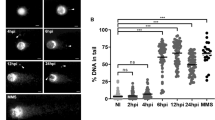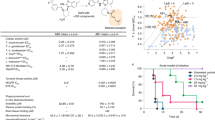Abstract
Trypanosoma cruzi, the etiological agent of Chagas disease, exhibits a single mitochondrion with an enlarged portion termed kinetoplast. This unique structure harbors the mitochondrial DNA (kDNA), composed of interlocked molecules: minicircles and maxicircles. kDNA is a hallmark of kinetoplastids and for this reason constitutes a valuable target in chemotherapeutic and cell biology studies. In the present work, we analyzed the effects of berenil, a minor-groove-binding agent that acts preferentially at the kDNA, thereby affecting cell proliferation, ultrastructure, and mitochondrial activity of T. cruzi epimastigote form. Our results showed that berenil promoted a reduction on parasite growth when high concentrations were used; however, cell viability was not affected. This compound caused significant changes in kDNA arrangement, including the appearance of membrane profiles in the network and electron-lucent areas in the kinetoplast matrix, but nuclear ultrastructure was not modified. The use of the TdT technique, which specifically labels DNA, conjugated to atomic force microscopy analysis indicates that berenil prevents the minicircle decatenation of the network, thus impairing DNA replication and culminating in the appearance of dyskinetoplastic cells. Alterations in the kinetoplast network may be associated with kDNA lesions, as suggested by the quantitative PCR (qPCR) technique. Furthermore, parasites treated with berenil presented higher levels of reactive oxygen species and a slight decrease in the mitochondrial membrane potential and oxygen consumption. Taken together, our results reveal that this DNA-binding drug mainly affects kDNA topology and replication, reinforcing the idea that the kinetoplast represents a potential target for chemotherapy against trypanosomatids.








Similar content being viewed by others
References
Barrett MP, Gemmell CG, Suckling CJ (2013) Minor groove binders as anti-infective agents. Pharmacol Ther 139:12–23. doi:10.1016/j.pharmthera.2013.03.002
Brack CH, Delain E, Riou G (1972a) Replicating, covalently, closed, circular DNA from kinetoplasts of T. cruzi. Proc Natl Acad Sci 69:1642–1646
Brack CH, Delain E, Riou G, Festy B (1972b) Molecular organization of the kinetoplast DNA of Trypanosoma cruzi treated with berenil, a DNA interacting drug. J Ultrastruct Res 39:568–579. doi:10.1016/S0022-5320(72)90122-0
Camargo EP (1964) Growth and differentiation in Trypanosoma cruzi I. Origin of metacyclic trypanosomes in liquid media. Rev Inst Med Trop 6:93–100
Cavalcanti DP, Gonçalves DL, Costa LT, De Souza W (2011) The structure of the kinetoplast DNA network of Crithidia fasciculata revealed by atomic force microscopy. Micron 42:553–559. doi:10.1016/j.micron.2011.01.009
De Souza W (2002) Special organelles of some pathogenic protozoa. Parasitol Res 88:1013–1025. doi:10.1007/s00136-002-0696-2
De Souza EM, da Silva PB, Nefertiti ASG, Ismail MA, Arafa RK, Tao B, Nixon-Smith CK, Boykin DW, Soeiro MNC (2011) Trypanocidal activity and selectivity in vitro of aromatic amidine compounds upon bloodstream and intracellular forms of Trypanosoma cruzi. Exp Parasitol 127:429–435. doi:10.1016/j.exppara.2010.10.010
Egbe-Nwiyi TN, Igbokwe IO, Onyeyili PA (2003) The pathogenicity of diminazene aceturate-resistant T. brucei in rats after treatment with the drug. J Comp Pathol 128:188–191. doi:10.1053/jcpa.2002.0599
Egbe-Nwiyi TN, Igbokwe IO, Onyeyili PA (2005) Diminazene aceturate resistence on the virulence of T. brucei for rats. J Comp Pathol 133:286–288. doi:10.1016/j.jcpa.2005.05.002
Elias MCQB, Faria M, Mortara RA, Motta MCM, De Souza W, Thiry M, Schenkman S (2002) Chromosome localization changes in the Trypanosoma cruzi nucleus. Eukaryot Cell 1:944–953. doi:10.1128/EC.1.6.944-953.2002
Hajduk SL (1979) Dyskinetoplasty in two species of trypanosomatids. J Cell Sci 35:185–202
Henriques C, Moreira TLB, Maia-Brigagão C, Henriques-Pons A, Carvalho TMU, De Souza W (2011) Tetrazolium salt based methods for high-throughput evaluation of anti-parasite chemotherapy. Anal Methods 3:2148–2155. doi:10.1039/C1AY05219E
Hill GC, Anderson WA (1969) Effects of acriflavine on the mitochondria and kinetoplast of Crithidia fasciculata. J Cell Biol 41:547–561
Jensen RE, Englund PT (2012) Network news: the replication of kinetoplast DNA. Annu Rev Microbiol 66:473–491. doi:10.1146/annurev-micro-092611-150057
Kennedy PGE (2013) Clinical features, diagnosis, and treatment of human African trypanosomiasis (sleeping sickness). Lancet Neurol 12:186–194. doi:10.1016/S1474-4422(12)70296-X
Korshunov SS, Skulachev VP, Starkov AA (1997) High protonic potential actuates a mechanism of production of reactive oxygen species in mitochondria. FEBS Lett 416:15–18. doi:10.1016/S0014-5793(97)01159-9
LIU B, LIU Y, MOTYKA SA, AGBO EEC, ENGLUND PT (2005) Fellowship of the rings: the replication of kinetoplast DNA. Trends Parasitol 21:363–369. doi:10.1016/j.pt.2005.06.008
Macadam RF, Williamson J (1972) Drug effects on the fine structure of Trypanosoma rhodesiense: diamidines. Trans R Soc Trop Med Hyg 66:897–904. doi:10.1016/0035-9203(72)90125-3
Macedo-Silva ST, Silva TLAO, Urbina JA, de Souza W, Rodrigues JCF (2011) Antiproliferative, ultrastructural and physiological effects of amiodarone on promastigote and amastigote forms of Leishmania amazonensis. Mol Biol Int 13:876021. doi:10.4061/2011/876021
Manchester TM, Cavalcanti DP, Zogovich M, de Souza W, Motta MCM (2013) Acriflavine treatment promotes dyskinetoplasty in Trypanosoma cruzi as revealed by ultrastructural analysis. Parasitology 140:1422–1431. doi:10.1017/S0031182013001029
Motta MC, de Souza W, Thiry M (2003) Immunocytochemical detection of DNA and RNA in endosymbiont-bearing trypanosomatids. FEMS Microbiol Lett 111:17–23
Palchaudhuri R, Hergenrother PJ (2007) DNA as a target for anticancer compounds: methods to determine the mode of binding and the mechanism of action. Curr Opin Biotechnol 18:497–503. doi:10.1016/j.copbio.2007.09.006
Peregrine AS, Mamman M (1993) Pharmacology of diminazene: a review. Acta Trop 54:185–203. doi:10.1016/0001-706X(93)90092-P
Pérez-Morga DL, Englund PT (1993) The structure of replicating kinetoplast DNA networks. J Cell Biol 123:1069–1079
Portugal J (1994) Berenil acts as a poison of eukaryotic topoisomerase II. FEBS Lett 344:136–138. doi:10.1016/0014-5793(94)00363-7
Regis-da-Silva CG, Freitas JM, Passos-Silva DG, Furtado C, Augusto-Pinto L, Pereira MT et al (2006) Characterization of the Trypanosoma cruzi Rad51 gene and its role in recombination events associated with the parasite resistance to ionizing radiation. Mol Biochem Parasitol 2:191–200. doi:10.1016/j.molbiopara.2006.05.012
Shapiro TA, Englund PT (1990) Selective cleavage of kinetoplast DNA minicircles promoted by antitrypanosomal drugs. Proc Natl Acad Sci 87:950–954
Silva CF, Meuser MB, De Souza EM, Meirelles MNL, Stephens CE, Som P, Boykin DW, Soeiro MNC (2007) Cellular effects of reversed amidines on Trypanosoma cruzi. Antimicrob Agents Chemother 51:3803–3809. doi:10.1128/AAC. 00047-07
Silva TM, Peloso EF, Vitor SC, Ribeiro LH, Gadelha FR (2011) O2 consumption rates along the growth curve: new insights into Trypanosoma cruzi mitochondrial respiratory chain. J Bioenerg Biomembr 43:409–417. doi:10.1007/s10863-011-9369-0
Simpson L (1968) Effect of acriflavine on the kinetoplast of L. tarentolae. Mode of action and physiological correlates of the loss of kinetoplast DNA. J Cell Biol 37:660–682
Storr SJ, Woolston CM, Zhang Y, Martin SG (2013) Redox environment, free radical, and oxidative DNA damage. Antioxid Redox Signal 20:2399–2408. doi:10.1089/ars.2012.4920
Stuart KD (1971) Evidence for the retention of kinetoplast DNA in acriflavine-induced dyskinetoplastic strain of Trypanosoma brucei which replicates the altered central element of the kinetoplast. J Cell Biol 49(189–195):1971
Trager W, Rudzinska MA (1964) The riboflavin requirement and the effects of acriflavin on the fine structure of the kinetoplast of Leishmania tarentolae. J Protozool 11:133–145. doi:10.1111/j.1550-7408.1964.tb01734.x
Wang MZ, Zhu X, Srivastava A, Liu Q, Sweat JM, Pandharkar T, Stephens CE, Riccio E, Parman T, Munde M, Mandal S, Madhubala R, Tidwell RR, Wilson WD, Boykin DW, Hall JE, Kyle DE, Werbovetz KA (2010) Novel arylimidamides for treatment of visceral leishmaniasis. Antimicrob Agents Chemother 54:2507–2516. doi:10.1128/AAC. 00250-10
Wilson WD, Nguyen B, Tanious FA, Mathis A, Hall JE, Stephens CE, Boykin DW (2005) Dications that target the DNA minor groove: compound design and preparation, DNA interactions, cellular distribution and biological activity. Curr Med Chem 5:389–408. doi:10.2174/1568011054222319
Witola WH, Atsuda A, Inoue N, Ohashi K, Onuma M (2005) Acquired resistance to berenil in a cloned isolate of T. evansi is associated with upregulation of a novel gene, TeDR40. Parasitology 131:635–646. doi:10.1017/S003118200500836X
Zuma AA, Cavalcanti DP, Maia MC, de Souza W, Motta MCM (2011) Effect of topoisomerase inhibitors and DNA-binding drugs on the cell proliferation and ultrastructure of Trypanosoma cruzi. Int J Antimicrob Agents 37:449–456. doi:10.1016/j.ijantimicag.2010.11.031
Zuma AA, Mendes IC, Reignault LC, Elias MC, de Souza W, Maçado CR, Motta MCM (2014) How Trypanosoma cruzi handles cell cycle arrest promoted by camptothecin, a topoisomerase I inhibitor. Mol Biochem Parasitol 193:93–100. doi:10.1016/j.molbiopara.2014.02.001
Acknowledgments
The authors are grateful to Rachel Rachid, Camila Silva Gonçalves, and Daniela Leão Gonçalves for technical assistance. This work was supported by Fundação Carlos Chagas Filho de Amparo à Pesquisa do Estado do Rio de Janeiro (FAPERJ), Conselho Nacional de Desenvolvimento Científico e Tecnológico (CNPq), and Programa de Apoios a Núcleos de Excelência (Pronex).
Ethical standards
Ethical approval was not required in this work.
Conflict of interest
We do not have conflict of interest to declare in this work.
Author information
Authors and Affiliations
Corresponding author
Electronic supplementary material
Below is the link to the electronic supplementary material.
Online Resource 1s
Analysis of the ROS generation in T. cruzi treated with berenil for 24 and 48 hours. ROS production enhanced in a time and concentration dependent manner. The data are the average of three independent experiments (GIF 50 kb)
Rights and permissions
About this article
Cite this article
Zuma, A.A., Cavalcanti, D.P., Zogovich, M. et al. Unveiling the effects of berenil, a DNA-binding drug, on Trypanosoma cruzi: implications for kDNA ultrastructure and replication. Parasitol Res 114, 419–430 (2015). https://doi.org/10.1007/s00436-014-4199-8
Received:
Accepted:
Published:
Issue Date:
DOI: https://doi.org/10.1007/s00436-014-4199-8




